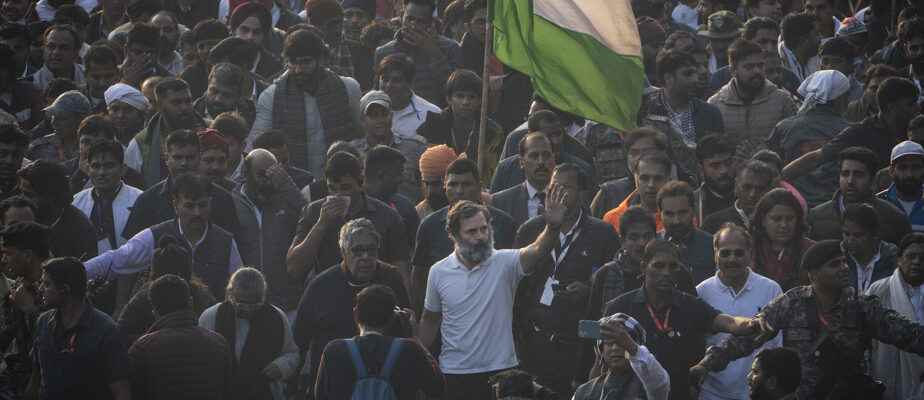Rahul Gandhi is dead, long live Rahul Gandhi.
At least that is what the main interested party claims, currently in the midst of a political resurrection after a series of electoral failures.
On September 7, Indira Gandhi’s grandson and Nehru’s great-grandson embarked on a 150-day, 3,500 km journey on foot across India to connect with the real world. Lush beard and immaculate white polo shirt, he advances with the constancy of a marathon runner, followed by the media and a crowd of supporters who seem to grow from village to village.
Officially, this Bharat Jodo Yatra (March for the Union of India) aims to bring the country together against the divisive policies of nationalist Prime Minister Narendra Modi, accused of sowing hatred and division between Hindus and Muslims. With this in mind, the heir to the Nehru-Gandhi dynasty does not hesitate to play the gurus, sowing on his way a message of tolerance, secularism and inclusion.

PHOTO ANUSHREE FADNAVIS, REUTERS ARCHIVES
“The old version of me no longer exists”, promises Rahul Gandhi.
“I opened a shop of love in the bazaar of hate,” he notably declared on December 19, as he passed through the town of Alwar in Rajasthan.
But for political analysts, there is no doubt that this political procession also aims to regenerate Mr. Gandhi’s party, the historic Indian National Congress (INC, linked to the country’s independence), 15 months from the legislative elections. planned in India in April 2024.

PHOTO NARINDER NANU, AGENCE FRANCE-PRESSE ARCHIVES
Rahul Gandhi, during his visit to the Harmandir Sahib – the golden temple – in Amritsar on January 10
Dominant force of the country for more than 50 years, the INC (centre left) has been in constant decline since the 1990s. It gives the image of a worn-out and ideologically confused political formation. His two successive defeats against the Bharatiya Janata Party (BJP) of Narendra Modi, with Rahul Gandhi at its head (2014 and 2019), confirmed this inexorable decline. The party now only holds 52 seats out of 543 in Lok Sabha (Indian Parliament) and only 3 states out of India’s 28.
In this sense, Rahul Gandhi’s march can certainly be seen as “a form of electoral rallying for progressive forces” in view of the battle to come, affirms Serge Granger, professor at the University of Sherbrooke and specialist in Sino- Indian.
By beating the drum in several provinces, he gives the impression that there really is a national party.
Serge Granger, professor at the University of Sherbrooke, specialist in Sino-Indian relations
Will this be enough to put the INC back on the path to victory? Professor of Indian politics at McGill University, Narendra Subramanian in doubt. The party is starting from very far and will sooner or later come up against the powerful electoral machine of the BJP.
However, the expert does not underestimate the impact of the operation: “There will be no dramatic change. A year and a half is not a long time to reverse the trend. But it can change things a bit in the right direction. It can bring more activists into the party. Give a little more vigor to the next campaign,” he says.
Mr. Subramanian also recalls that Modi’s party only won 37.7% of the vote in 2019, which puts its overwhelming majority of 303 seats in Parliament into perspective. If the INC manages to get back in the game and crystallize the growing dissatisfaction with the government, nothing excludes that the BJP wins without a majority.
“A victory for the Congress would be to make the BJP a minority,” adds Serge Granger.
more believable
The culture of the political procession (yatra) is not new to India.
Mahatma Gandhi had struck the spirits in 1930 with his “salt march”, started to wrest India’s independence from the British.
In 1990, a young Narendra Modi crossed the country from east to west with the aim of going to rebuild the temple of the Hindu god Rama, in the city of Ayodhya.
In 2020, peasants marched to Delhi to protest agricultural reform. With success.
The future will tell if the Bharat Jodo Yatra of Rahul Gandhi will bear fruit. But according to Narendra Subramanian, it suggests a beautiful political renaissance for the figurehead of the Indian National Congress.
Accused of being disconnected from the real people, described as “a student who would have done his homework to impress the professor” without having the necessary aptitudes for politics (Barack Obama, Memoirs), caricatured by Modi as the “prince” heir to a corrupt family, Gandhi has long been met with skepticism.
But now we are starting to take it seriously.
“I think part of this walk helps him show himself in a new light,” concludes Mr. Subramanian. By saying, “the old version of me no longer exists,” he no doubt hopes that people will find him more credible as a political leader. There may be a part of marketing. But he hasn’t been a great politician so far. And for the first time, he’s showing signs of someone who understands mass politics and knows what works to reach the people. »
Learn more
-
- 1885
- Indian National Congress founding year
- 1947
- India’s Independence Year, when the INC is in power
